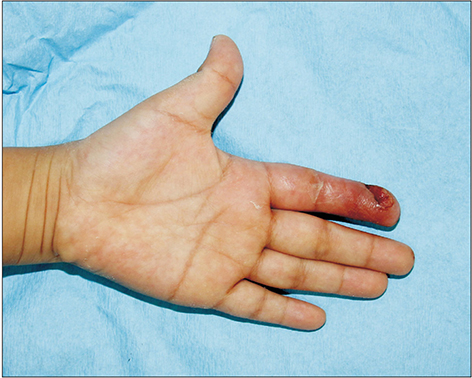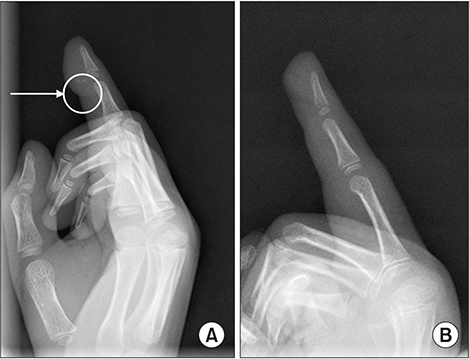Arch Hand Microsurg.
2019 Jun;24(2):162-166. 10.12790/ahm.2019.24.2.162.
Tenosynovitis on Finger in Children due to Shewanella algae
- Affiliations
-
- 1Department of Plastic and Reconstructive Surgery, Soonchunhyang University College of Medicine, Cheonan, Korea. medi619@hanmail.net
- 2Institute of Tissue Regeneration, Soonchunhyang University, Cheonan, Korea.
- KMID: 2448050
- DOI: http://doi.org/10.12790/ahm.2019.24.2.162
Abstract
- Infection of the hands is a relatively common disease that can occur after the injury of the fingers. Commonly, these common diseases can be treated with empirical antibiotic therapy within accurate and detailed information from their patients. But, some health care providers often simply think about this disease as simple infection and inflammation and just prescribe the empirical antibiotics without precise medical examination. Depending on the source of the infection, some patients will not readily fit into the standard antibiotic regimens that are commonly used for community pathogen. If accurate diagnosis within early treatment is delayed, it will cause the complications such as tenosynovitis, osteomyelitis and necrotizing fasciitis. By way of example, we describe the rare case of critically exacerbated from simple laceration to tenosynovitis caused by Shewanella algae whose infection was related to his initial injury and not the subsequent treatment.
Keyword
MeSH Terms
Figure
Reference
-
1. Tosti R, Ilyas AM. Empiric antibiotics for acute infections of the hand. J Hand Surg Am. 2010; 35:125–128.
Article2. McDonald LS, Bavaro MF, Hofmeister EP, Kroonen LT. Hand infections. J Hand Surg Am. 2011; 36:1403–1412.
Article3. Osterman M, Draeger R, Stern P. Acute hand infections. J Hand Surg Am. 2014; 39:1628–1635. quiz 1635.
Article4. Jacob-Kokura S, Chan CY, Kaplan L. Bacteremia and empyema caused by Shewanella algae in a trauma patient. Ann Pharmacother. 2014; 48:128–136.
Article5. Fowler JR, Ilyas AM. Epidemiology of adult acute hand infections at an urban medical center. J Hand Surg Am. 2013; 38:1189–1193.
Article6. Houshian S, Seyedipour S, Wedderkopp N. Epidemiology of bacterial hand infections. Int J Infect Dis. 2006; 10:315–319.
Article7. Türker T, Capdarest-Arest N, Bertoch ST, Bakken EC, Hoover SE, Zou J. Hand infections: a retrospective analysis. PeerJ. 2014; 2:e513.
Article8. MacDonell MT, Colwell RR. Phylogeny of the Vibrionaceae, and recommendation for two new genera, Listonella and Shewanella. Syst Appl Microbiol. 1985; 6:171–182.
Article9. Derby HA, Hammer BW. Bacteriology of butter. IV, bacteriological studies on surface taint butter. Ames: Agricultural Experiment Station, Iowa State College of Agriculture and Mechanic Arts;1931.10. Hau HH, Gralnick JA. Ecology and biotechnology of the genus Shewanella. Annu Rev Microbiol. 2007; 61:237–258.
Article11. Janda JM, Abbott SL. The genus Shewanella: from the briny depths below to human pathogen. Crit Rev Microbiol. 2014; 40:293–312.12. Nozue H, Hayashi T, Hashimoto Y, et al. Isolation and characterization of Shewanella alga from human clinical specimens and emendation of the description of S. alga Simidu et al., 1990, 335. Int J Syst Bacteriol. 1992; 42:628–634.
Article13. Liu PY, Lin CF, Tung KC, et al. Clinical and microbiological features of shewanella bacteremia in patients with hepatobiliary disease. Intern Med. 2013; 52:431–438.14. Vignier N, Barreau M, Olive C, et al. Human infection with Shewanella putrefaciens and S. algae: report of 16 cases in Martinique and review of the literature. Am J Trop Med Hyg. 2013; 89:151–156.
Article15. Martín-Rodríguez AJ, Martín-Pujol O, Artiles-Campelo F, Bolaños-Rivero M, Römling U. Shewanella spp. infections in Gran Canaria, Spain: retrospective analysis of 31 cases and a literature review. JMM Case Rep. 2017; 4:e005131.
Article16. Fluke EC, Carayannopoulos NL, Lindsey RW. Pyogenic flexor tenosynovitis caused by Shewanella algae. J Hand Surg Am. 2016; 41:e203–e206.
Article
- Full Text Links
- Actions
-
Cited
- CITED
-
- Close
- Share
- Similar articles
-
- Primary Shewanella algae Bacteremia Mimicking Vibrio Septicemia
- A Case of Spontaneous Bacterial Peritonitis with Bacteremia Caused by Shewanella algae
- A Case of Shewanella algae Bacteremia Accompanying Cellulitis in Both Legs of a Patient on Hemodialysis: Case Report and Literature Review
- A Case of Endophthalmitis Caused by Shewanella algae after Trauma
- Treatment of Chronic Isolated Finger Flexor Tenosynovitis Through 50% Dehydrated Alcohol Installation




